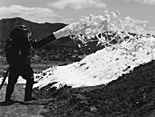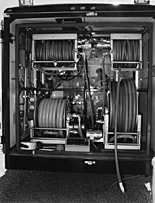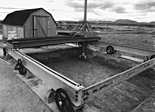


 The U.S. Department of Energy is working on making cleanups safe. Two technologies addressing environmental, health, and safety concerns during cleanups are the Contamination Control Unit and dig-face characterization. The CCU, developed under the program now known as the landfill stabilization focus area, is ready for environmental restoration use and emergency response throughout the DOE complex. Dig-face characterization is still being developed and tested by DOE's Office of Technology Development under its landfill stabilization focus area.
The U.S. Department of Energy is working on making cleanups safe. Two technologies addressing environmental, health, and safety concerns during cleanups are the Contamination Control Unit and dig-face characterization. The CCU, developed under the program now known as the landfill stabilization focus area, is ready for environmental restoration use and emergency response throughout the DOE complex. Dig-face characterization is still being developed and tested by DOE's Office of Technology Development under its landfill stabilization focus area.
Contamination Control Unit
The CCU is a system for delivering dust suppression and soil fixative products to excavations where workers and the environment are exposed to contaminated dust. The CCU can also be used by emergency responders for hazardous and radioactive materials incidents. The mobile unit, mounted on a 9 X 26 foot trailer, houses vacuum, water mister, soil fixative, and dust suppressant systems. The CCU is designed to work with a variety of contamination control products. Product testing will continue to define optimal uses for these products under specific conditions. All products are non-hazardous and can be disposed of in sanitary landfills.
 The CCU's vacuum, equipped with a High Efficiency Particulate Air filter and a 55-gallon waste container, can pull debris as large as 1.5 inches in diameter through 100 feet of hose. The vacuum system can rapidly decontaminate equipment, personnel, and work areas. The water misting system, Dryfog (manufactured by Sonics, Inc.), contains a 300-gallon water supply and uses compressed air to force demineralized water through six nozzles. The spray captures and removes airborne soil generated during digging and dumping operations. A test of the DryFog Misting System revealed that constructing a tent over the digface controls wind and optimizes the system.
The CCU's vacuum, equipped with a High Efficiency Particulate Air filter and a 55-gallon waste container, can pull debris as large as 1.5 inches in diameter through 100 feet of hose. The vacuum system can rapidly decontaminate equipment, personnel, and work areas. The water misting system, Dryfog (manufactured by Sonics, Inc.), contains a 300-gallon water supply and uses compressed air to force demineralized water through six nozzles. The spray captures and removes airborne soil generated during digging and dumping operations. A test of the DryFog Misting System revealed that constructing a tent over the digface controls wind and optimizes the system.
The CCU is also supplied with soil fixative, a product that when cured forms a crust over soil to stabilize it. The soil fixative, 3M Foam (manufactured by 3M, Inc.), combines with water and a stabilizer and is pumped through nozzles. It is a pale yellow, long-term vapor suppressing foam for covering and stabilizing steep sloping digfaces and other non-traffic areas. Tests have revealed 3M Foam to be an excellent fixative for forming a tough barrier over soil. However, its toughness hinders the digging operation. Although expensive, its best use is as a longer-term crusting agent for stabilizing areas of the excavation site that will be left undisturbed.
The dust suppressant, Flambinder (manufactured by Flambeau Corporation), is used on U.S. Forest Service roads to suppress dust. This product is mixed with water, stored in a 325-gallon tank, and pumped to a nozzle through a hose and reel system. It cures in a few hours and can withstand traffic from hundreds of vehicles without reapplication.
The CCU is capable of fixing or stabilizing 500 square feet a minute, or dust suppressing 1,000 square feet in 15 minutes while simultaneously misting two gallons a minute from six misting nozzles. The vacuum system can operate continuously during the spray operation. In an emergency, the system can spray dust suppressant at a rate of 1,000 square feet in three minutes.
During May 1993, the CCU was used at the Idaho National Engineering Laboratory to suppress dust during an excavation of three contaminated soil areas covering approximately 70,000 square feet near a decommissioned reactor building. This was the first time the CCU was used during excavation of an actual contaminated site. The CCU supported a simulated transuranic buried waste retrieval demonstration at INEL's Cost Test Pit during July 1993. The CCU was tested using dust suppressants on vehicle traffic surfaces; the misting system and soil fixatives were used over the excavation and dumping areas. DOE's Environmental Restoration Program at the Hanford Site in Washington used the CCU during a September and October 1993 excavation of a plutonium crib and surrounding transuranic soil contaminated with reactor waste. The CCU suppressed dust with water and a variety of dust suppressants.
The CCU is ready for use throughout the DOE complex. A full-scale test or additional applications will provide data to refine the system and develop optimal uses for a variety of contamination control products. One planned CCU improvement is to modify it for remote operation. For this to be successful, a feedback system that can provide real-time information on dust and contamination levels must be developed.
Dig-face Characterization
 Dig-face characterization uses environmental sensors at the digface, or excavation surface, to detect and warn of buried hazards such as drums of waste, reactor cores, or explosives. The technology, which is still under development, will also assess changing soil conditions during remediation. Through a remotely operated system of environmental sensors, the remediation operation will be adjusted in response to continuous, real-time information provided by the characterization technology.
Dig-face characterization uses environmental sensors at the digface, or excavation surface, to detect and warn of buried hazards such as drums of waste, reactor cores, or explosives. The technology, which is still under development, will also assess changing soil conditions during remediation. Through a remotely operated system of environmental sensors, the remediation operation will be adjusted in response to continuous, real-time information provided by the characterization technology.
Development and testing of dig-face characterization is proceeding on several fronts. Three prototype sensors have been developed, tested, and are being refined—the gamma neutron sensor, which is a radiological detector; the dielectric permittivity sensor, which is a geophysical sensor; and the volatile organic compound sensor, which is a type of chemical detector.
In August 1993 and August 1994, a prototype dig-face characterization system was tested at the Cold Test Pit of the Idaho National Engineering Laboratory. Commercial sensors deployed with a manual non-metallic trolley were tested for their accuracy and clarity in depicting simulated contaminated soil conditions and non-hazardous objects planted to mimic an actual underground storage site. Each scan of the sensors over the simulated site provided new data as soil layers were removed in small increments. The resolution capability of the sensors was compared with the known topography and soil conditions in the area. This test proved the feasibility of using environmental sensors as predictive tools for decision making during remediation.
This summer, dig-face characterization is scheduled to be used to guide an actual retrieval at the Mound Site in Ohio. Actinium 227, a by-product of bomb production, is leaking from underground storage tanks. The data provided by the dig-face sensors will be interpreted by software to map the contaminant plume and provide information for the safe removal of tanks and contaminated soil. A remotely controlled gamma neutron sensor deployed on an automated trolley platform will make multiple passes over the digface. Each pass of the gamma neutron sensor will send data to a computer. Interpretation software will produce color contour maps to illustrate the scope and level of radioactivity at each stage of the dig. Proceeding in small, safe steps, the retrieval will be adjusted to changing conditions as reflected in the data collected at the digface.
DOE's Idaho Operations Office and Lockheed Idaho Technologies Co. are involved in developing this technology. It is expected the dig-face characterization technology will have commercial applications in manufacturing, mining, waste cleanup operations, and archeological projects.